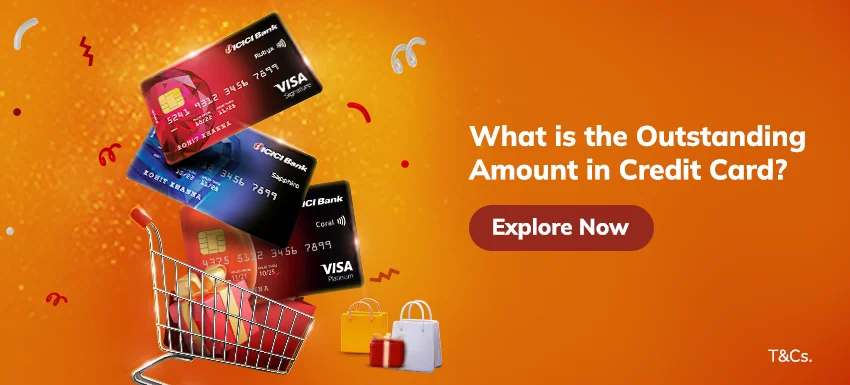THE
ORANGE
HUB
What does outstanding amount on a Credit Card mean?

Outstanding amount on a Credit Card
A Credit Card is an excellent payment tool to manage everyday expenses. It allows you to purchase things now and pay later. Each Credit Card statement you receive at the end of the billing cycle mentions the outstanding amount.
The outstanding amount on a Credit Card is the total amount you owe on your Credit Card, consisting of purchases and previous due amount.
The outstanding amount is the current balance that indicates the total unpaid dues that you are liable to pay. It consists of various elements including balance transfers, online or offline purchases, cash advances, applicable fees, interest charges and any other charges. Basically, it summarises your Credit Card Account in real time and gets updated after each Credit Card transaction.
Why is it important to monitor the outstanding amount on a Credit Card?
Monitoring the outstanding amount on a Credit Card is essential as it helps to determine the credit limit still available for use. For instance, purchasing something worth ₹1,000 becomes a part of the outstanding amount. Subtract the outstanding amount from the existing credit limit of your Card to calculate your remaining credit limit.
Suppose your credit limit is ₹50,000 and your current outstanding amount is ₹20,000, then the current credit limit available for use will be ₹30,000. If you initiate another transaction worth ₹5,000 then your available credit limit will be ₹25,000.
Do you want to know the outstanding amount on your Credit Card? Access your account online through ICICI Bank Net Banking or iMobile Pay. Enter a few required details and view your statement.
Difference between outstanding amount and statement balance: Now that you know what is the outstanding amount on a Credit Card, understand how it differs from the statement balance.
- Billing cycle: The billing cycle is not the same as the calendar month. It begins from the opening date of the statement and ends on its closing date. Learning this timeframe is essential to understand the 2 types of balances.
- Timing: While a statement balance indicates all transactions you carry out in a billing cycle, the outstanding amount is the total amount you owe currently. It may include due amount from previous months and amount spent after the statement closing date.
- Updates: The outstanding amount fluctuates with recent transactions on the Card. On the other hand, the statement balance stays constant until the next monthly statement.
Here is an overview of the differences between the two:
| Parameter | Outstanding amount | Statement balance |
|---|---|---|
Meaning |
Indicates the total amount you owe at the moment, including the due amount from previous months and amount spent after the statement closing date. |
Reflects all Credit Card transactions during a billing cycle. |
Billing cycle |
NA |
The billing cycle depends on the specific period between the opening date and closing date of the statement. |
Timing |
Represents your economic status at a specified/given time |
Represents your finances at the end of a billing cycle |
Reporting to Credit Bureaus |
The outstanding amount indicates your most recent transactions using a Credit Card, thus impacting your credit rating. |
The statement balance checks your credit activity at the end of a billing cycle. |
Balance amount |
Accurate, till it is generated and is updated with each transaction. |
Remains constant until the next billing cycle and captures activities until the generation of the next statement. |
Decision Making |
Allows real time decision making based on the outstanding liability.
|
Helps to understand your financial status at the end of each billing cycle. |
Strategies to manage and reduce the outstanding amount:
- Pay more than the minimum amount: Paying only the minimum amount due each month can keep you in debt for years and lead to high interest charges. By paying more than the minimum amount due or total amount due, you reduce the principal amount faster, which limits the interest accrued over time and helps you clear your debt quickly.
- Set up automatic payment: Automatic payment ensures that you never miss a due date, helping you to avoid late fees and potential negative impact on your credit score. This strategy is particularly useful if you tend to forget the payment dates. Set up automatic payment to cover at least the minimum amount or ideally more, to keep your debt under control.
- Use balance transfer options: If you have high interest Credit Card debt, consider transferring the balance to a Card with a lower interest rate. Many Credit Card companies and banks offer a promotional 0% interest rate for balance transfers. This can significantly reduce the amount of interest you pay, allowing you to pay the principal amount more effectively.
Having a high outstanding amount on your Credit Card significantly impacts your credit score, making it difficult for you to avail more credit in the future. Therefore, paying the outstanding amount on a Credit Card in time is crucial. With the right practices, you can use a Credit Card responsibly and maintain a healthy credit rating while avoiding any financial setbacks.











